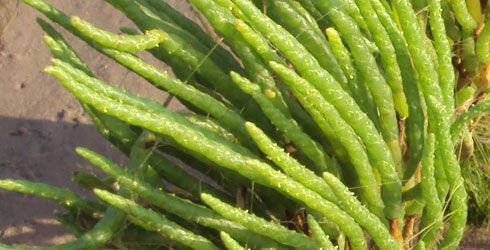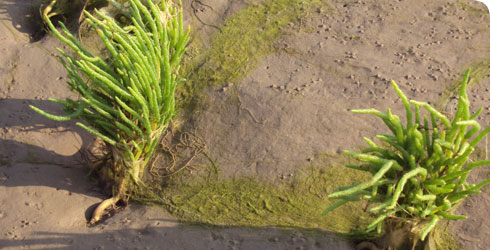Salicornia dolichostachya
The long-spiked glasswort is one of many species of Salicornia (glassworts) living in salt marshes around British and Irish coasts.
Glassworts are not seaweeds but flowering plants belonging to the Goosefoot family (Chenopodiaceae).
They can be easily recognised by their branched fleshy stems which appear to have no leaves.
Salicornia dolichostachya is difficult to tell apart from other similar species.
These plants are are highly adapted to the extreme environment of the sea shore which means:
- they are covered by salt water for much of the day
- they are rooted in salty, water-logged mud
As such, they make an important contribution to the transformation of mud flats into salt marshes.
Species detail
-

Taxonomy
Salicornia dolichostachya is a succulent annual plant that grows up to 45cm tall and looks very much like its close relatives. Find out more.
-

Distribution
Salicornia dolichostachya is found in salt marshes across northern Europe. Discover how the long-spiked glasswort has adapted to its extreme environment and how it helps make the salt marshes suitable for other plants too.
-

Biology
Find out what the Salicornia dolichostachya plant, and its flowers, look like.
-

Uses
Glassworts can be used to make glass, or a tasty dish. Find out more about its diverse uses.
-
References
Get reference material for Salicornia dolichostachya.
Images

Salicornia dolichostachya growing on Walney Island, Cumbria.
© Dr Robert Huxley
Salicornia dolichostachya.
© Dr Robert Huxley
Salicornia dolichostachya showing yellow stamens and anthers protruding from the flower pores.
© Dr Robert HuxleyAbout the author
A word from the author
"I was brought up close to the salt marshes of south-west Lancashire and have been lucky to work in these fascinating environments for over 35 years. I still look forward to the few days a year survey work that allows me to stand soaking-wet and muddy-booted on the shore watching the falling tide reveal an expanse of vegetation. Glassworts symbolise what is arguably the most extensive extreme environment for plants in the UK and play a key role in creating that habitat. They are also one of the only 'seafoods' that I will eat!"
Some common names for Salicornia dolichostachya:
- marsh samphire
- long-spiked glasswort
- pickleweed

